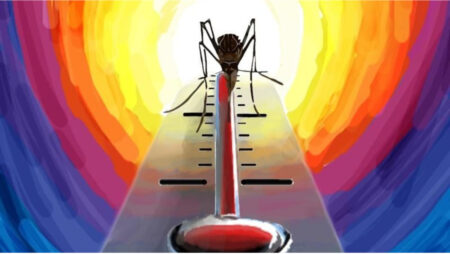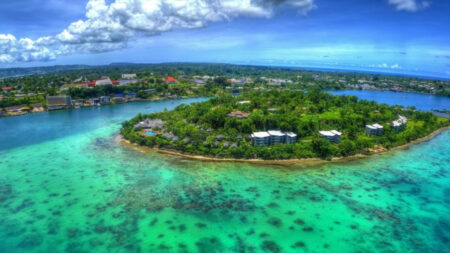The spontaneous eruption of the submerged volcano in the Pacific Ocean stunned the world.
On Saturday, January 15, at almost a quarter to five in the evening, local time, an undersea volcano exploded near the archipelago of Tonga in the Pacific Ocean. The uninhabited island where the volcano erupted is about sixty-four kilometres north of the capital, Nuku’alofa, of the island kingdom of Tonga.
According to the experts, the volcano, Hunga Tonga-Hunga Ha’apai, became active in 2007 and was discovered by NASA in 2015. It lies along the Pacific “Ring of Fire” (The Circum-Pacific Belt), an area in the Pacific Ocean home to the world’s most active volcanoes and earthquakes.
The unprecedented eruption created a vast “mushroom cloud” and was heard and felt by other countries across the ocean. It reached at least thirty kilometres into the stratosphere. Jason Tackett, a researcher at NASA’s Langley Research Center, noted it as, “The highest volcanic plume measured by CALIPSO (Cloud-Aerosol Lidar and Infrared Pathfinder Satellite Observations; an environmental satellite).
The Tsunami
The explosion gave rise to a tsunami with waves of around fifteen kilometres in height which swept the surrounding islands. It also caused a disturbance in the waves in the ocean, which were recorded by other countries as well like Japan, New Zealand, Fiji, Peru and as far as the United States.
The islands of Mango, Nomuka and Fonoifua have incurred severe damages so far. Authorities confirmed three deaths, two locals and a British woman on Tuesday, along with several injured. A report from the UN humanitarian official was that all the houses on the island of Mango were destroyed, with only two remaining in Fonoifua.
The majority of the residents lived on the main island, Tongatapu, where around 50 houses were damaged with extensive damage on the island of Nomuka.
Being an archipelago in Oceania, Tonga was connected through a single underwater fibre-optic cable to the rest of the world. It was damaged during the explosion, putting the nation in complete radio silence. Only some of the local communication was working, the internet and telecommunication were down.
Due to the ash cloud shrouding the islands after the eruption, it was challenging to assess the damage through satellites.
A New Zealand aircraft did an air assessment after the volcanic ash cleared. UN spokesperson Stephane Dujarric revealed that nearly eighty thousand people, i.e., eighty per cent of the population, were affected by this unexpected tragedy.
The authorities remarked that the main concern is the lack of freshwater since the ash and debris from the blast has polluted the water. The other is acid rain, but the change in the direction of the wind may prevent Tonga from getting affected by it.
On Thursday, January 20, after the clearance of the runway of the primary airport on the island, neighbouring countries started to send in help. New Zealand’s Foreign Minister, Nanaia Mahuta, reported that it has sent air aid carrying drinking water, survival kits, hygienic supplies, generators and communications equipment and is preparing another two with humanitarian supplies. Australia is also preparing to send help and other countries like China and the U.S.
The officials also cleared ships to dock on the island of Tongatapu. There are two ships from New Zealand already on the way. One carries 250,000 litres of water and a desalination plant capable of producing around seventy thousand litres of water per day. The other is equipped with survey and diving teams.
Since there was only one case of Covid-19 in Tonga and the island country has succeeded in avoiding the spread of the virus so far, the nation is hoping for “contactless disaster relief”. The government does not want to swap one disaster with another.
Tonga’s Red Cross volunteers have already started distributing survival kits and other necessary crucial supplies to the people.
Effect on other countries
The eruption was heard in Fiji (800 km away) and New Zealand (2500 km away). Shockwaves also got recorded in the U.S. at Alaska Volcano Observatory (>9500 km away) and in Chennai, India (12,000 km away) after ten hours when it occurred. According to S. Venkataramanan, PhD scholar at IIT Madras, who noted the change in atmospheric pressure due to the eruption, the shockwave’s speed was around 1200 kmph.
After the eruption, due to the emergence of tsunami waves, a warning was issued in the coastal regions of Japan, the U.S., the east coast of Australia, Tasmania and New Zealand.
Fiji and Vanuatu, neighbouring archipelagos, set out warnings for evacuation from the coastal regions. Japan recorded waves of 1.2 m high from the tsunami.
Peru got hit with an oil spill due to the blast from the volcano. The country’s government has declared it “the worst ecological disaster” to date.
What now?
The damage incurred by this coral reef-lined nation, which killed three people, got several injured, destroyed houses and almost wiped out many of its smaller islands, is still being evaluated. The death toll is expected to rise, and many challenges are lying ahead for the country’s people. The evacuation from surrounding islands is underway.
The ashes from the eruption have settled, communication is back online. The internet will probably take months to get back up, the damage to the environment and the economy more than that, and the reversal to normal livelihood probably much longer. Still, only time will tell the future outcome of this unpredicted calamity on the ecosystem and economy of the country.
Edited By- Mahi Gupta
Published By- Saloni Agarwal












